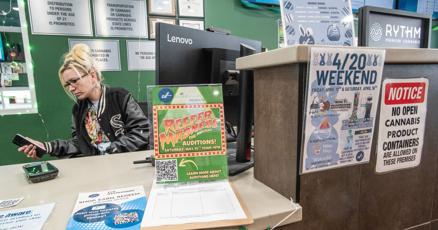[[{“value”:”
JEFF SOENKSEN is the director of retail operations at The Dispensary, which opened a Champaign location last year. With his 14 years in the cannabis industry, starting in Colorado, he has some perspective on how things have changed… and what’s to come. He sat down with the News-Gazette’s Luke Taylor to talk all things weed in Champaign-Urbana.
This interview has been lightly edited for length and clarity.
Here in Illinois, weed has only been legal for five years. How have you seen the culture around weed and cannabis change with legalization?
In the beginning, at least out in Colorado, it was still pretty … I guess the term would be “grassroots” or “hippy-esque” or like the portrayals you see on the Netflix series, that stereotypical stoner experience.
Through the years of cannabis and as popularity of legalization has grown, we’ve seen a lot more of a corporate structure come into play, especially as you head east in the state. The western coast is still that more laid back hippy kind of feel, where as we travel east, especially in Illinois, which has become a lot of cannabis companies’ corporate headquarters, I think we’re just seeing a lot more standardization and … other business practices kind of coming in to the legalized storefronts.
You’re starting to see more of those Apple-style stores with technology and more resources, where in the beginning everything was more or less, you know, pick up a jar, smell it, look at the bud, everything’s weighed in front of you. It was just kind of like the tie dye on the wall.
We’ve definitely seen a lot of investments and a lot of changes in the industry as a whole, from a corporate structure and just becoming more organized, I’d say.
You mentioned how the perception of an average cannabis user has changed. Talk a bit about what your clients are like versus those stereotypes.
There are two types of newer individuals we see.
I call the first group the “closet” cannabis user, where they’ve been using longer than anyone would know, but they’re very closed about it in their personal life. (Legalization) just gives them the opportunity to be more open and free with their usage.
I found that rather surprising as things kind of transitioned to not needing a medical card and just being the age of 21 to purchase.
As the industry has grown and the social acceptability started changing, we see a lot of newcomers primarily in the older generations. We get a lot of first time users between the ages of 40 and 60-plus.
They come in, I’d say mainly looking for either pain relief or help sleeping, but there’s people just looking to have a good time or everything in between.
The most common user that we see new to the market would be those older generations who grew up around the whole “War on Drugs” campaign and “Reefer Madness.”
How have the products you’re selling changed?
There haven’t been a lot of changes to the traditional product of dried, smokeable flower, but I’d say that the technology and science around growing cannabis in general, that has exploded in the past 10 years or so.
With that, we’re seeing increased potency in the product itself, and just more genetics coming out and different hybrid strains that can offer various ways to get relief and use the products.
I think the biggest change to the industry since legalization is the innovation on the vaporizers.
Ten years ago, you probably weren’t seeing a lot of cannabis vapes from the market, and it’s the second highest category of sales in Illinois. I imagine for most of the cannabis industry, it really opened the doors for a way to consume where you’re not combusting plant material and the odor isn’t as invasive.
People in apartment complexes, or people that you know can’t go up and light up a joint that someone two blocks away is going to smell, they have better means to consume the products.
From there, I would say the innovation in edibles. In the past few years, we’ve seen the technology, it’s called nanotechnology, with cannabis edibles, where we’re seeing like those quick onsets.
Where typically ingestion of those cannabinoids will take anywhere from 30 minutes to two hours to kick in, these quick onsets get you feeling the product within about 15 minutes and it has a shorter duration time, so a little bit more control over your delivery methods.
We’ve also seen the industry kind of switch to the microdose mentality, where 10-12 years ago, we weren’t really seeing these two milligram and five milligram doses. It was just everyone wanting to get as high as possible, like 25, 50, 100 milligram doses.
We’re seeing a lot more, a lot more products tailored to the microdose or just treating effects as opposed to just like using it as a fun weekend products to kind of disassociate from real life.
Where do you see the industry in 10 years? What changes do you think are coming down the line?
That depends on the federal government at this point. This is definitely a broader conversation.
The 280e tax code which was developed during the War on Drugs era, to essentially not allow for business deductions for drug dealers, but inherently, this has caused our state-legal businesses to not have standardized business deductions.
We’re not even recognized as a business from the federal government, but we still pay taxes.
What this means is we get no standardized tax deductions, so we are double-taxed on everything, which creates a lot of hurdles in our industry.
It creates a lot of cash-poor instances, with very large bars to entry into the industry, as you can’t get loans for startups, so we’re kind of hit on all ends.
With the way everything’s going, cannabis needs tax relief.
When you think of cannabis, people just think of dollar signs, so what that causes is what we always refer to as the “green tax.”
No matter what you’re doing, hiring a contractor doing just any basic business necessity is going to cost you more because you have cannabis linked to you.
Whether that’s the rescheduling of cannabis out of Schedule I, which means “no medical value” — we’ve seen numerous times that there is medical value there which needs some more research — or if it’s simply redefining the businesses that fall under 280e federal tax codes… I think until 280e is solved, it’s going to be some painful growth from here, as more states start to legalize either medicinally or recreationally.
You guys are one of five dispensaries here in Champaign-Urbana. What’s the local market like? Is there a lot of competition or do you see room for growth?
Like you said, it’s a saturated market. I think the biggest challenges are around advertising to allow for that growth.
Most radio stations won’t advertise for cannabis businesses, even though there’s nothing saying they can’t. We abide by these strict regulations, but these businesses, you know, they still choose not to necessarily work with us.
We’re really restricted on just our means to get information out to our consumers or potential consumers. Social media accounts get shut down constantly.
We’re really restricted in how we can just let people know that we’re a member of the community. Again, kind of falls in with the hurdles and nuances of trying to operate a business that’s technically federally illegal but state legal.
The Dispensary has locations in two other Illinois cities, Fulton and Dubuque. How does the Champaign location compare to those other two spots?
It’s definitely slower. Our Fulton and east Dubuque stores are border locations where we were the only operators there for quite some time.
Cannabis consumers are pretty loyal to their businesses, so any time new businesses come into the market after years of established rapport with the customers, it always takes some time to break into those markets.
We’re not quite a year into operations, but we’re taking all the feedback we can get from consumers on both how we can better serve them and how we can become more known in the community.
As a mom-and-pop, we operate on limited resources, and approach challenges every day and every month to try to compete with some of the larger companies, especially in the Illinois market.
Before marijuana was legalized in Illinois, there were a lot of fears about safety with people driving or smoking in public. None seem to have materialized in a significant way. Have you seen those negative perceptions start to change because they’ve kind of been proved wrong?
I think a small portion come around and say, “Wow, we didn’t see these things that some people brought up as concerns happen,” but I’d say nine times out of ten, we never really hear from individuals that had those concerns again.
I don’t know if it’s ever been brought up to some communities, like two years later, “these were the concerns, this is where we’re at today” with that stuff.
I’d love to see more comparisons, because I know there were some pretty loud voices of people against cannabis legalization. I’d love to see some more studies in the communities that have these dispensaries, and kind of which way things went.
We personally try to work with our city officials to ensure we’re good partners and what we typically see is with the amount of security our facilities have, crime actually is reduced in the area.
We have to hold these recordings, and we can help with any investigations, or if anything happens in the area we work directly with local police to pull camera footage or find out what happened.
We go through rigorous ID checks to purchase from us, so we do find and stop a lot of fake IDs that are getting through the bars or other places that might not have as close of eyes on some of these things. We support the community by, you know, taking some of the minors’ fakes off the streets.
We’re proud to be a part of the Champaign community. We hope people consider giving us a try in the future, and if there’s any way to plug it, we’re going to be doing a very special play of the hit movie “Reefer Madness” at the Canopy Club in July. Look out for more information on that in the coming months.
”}]] JEFF SOENKSEN is the director of retail operations at The Dispensary, which opened a Champaign location last year. With his 14 years in the cannabis industry, starting in Colorado, he Read More


